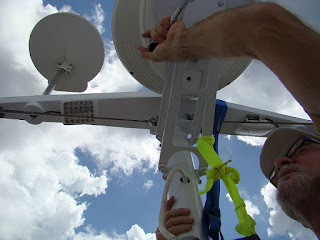I suppose theoretically it's possible. But can you really repair a 30-year-old radar unit for $30.00? I am here to tell you that you absolutely can, if the problem is the same as ours. Not long ago, I fired up our Raytheon SL70 radar unit and it all started fine. Once it was going, however, the beam was doing the sweeps, but there were no targets on the display. An internal self diagnostic showed everything was working okay, but obviously it wasn't. This unit is long past its manufacturing date and it's highly doubtful if Raymarine will even fix these any more or if it's worth it. So trying a few things couldn't hurt.
A short climb up our mast, and a little gymnastics, allowed me to remove the end of the cable from the back of the scanner. The weak link in these units has always been the fragile 8-pin plug that attaches the cable to the scanner and provides all of the data the display needs to function properly. The wires are very small and the flat plastic plug is very easy to damage. Upon further inspection, I found two wires that virtually came apart once I started moving them around. So the problem became obvious. But was the solution going to be simple? I considered doing some kind of direct connection between the wiring in the scanner and the cable. How complicated that would be was hard to tell without taking everything apart. So on to the computer for research. It seems this is a common problem and many folks either replaced the entire radar or replaced the cable with a used one purchased somewhere online like from Ebay or from individuals who were upgrading and had working units they wanted to sell. But well into about 10 pages on Google Search, I found a reference to a Raymarine part to repair the plug. But did Raymarine still sell the part?
It turns out that they do. An online search shows it's even available at Amazon.com and Raymarine will sell the product, part number R126, directly. It's only about $20, and with shipping, brought it to about $30.
The pins require a special crimping tool, which I don't have, but I was
successful in crimping the pins with a pair of needle nose pliers. Care
also needs to be taken to be sure that the wires are in the right
sequence and that the pins are inserted into the plug in the correct
orientation. They will actually snap into place and not be pushed back
out when the plug is inserted if they are installed correctly. With the new plug attached and inserted in the scanner, and the power wires reconnected, it was time for the moment of truth.
And it works. Considering that a new radar unit would cost us about $3,000, I think this $30 investment really paid off. Sure we would like to have the latest and greatest in broadband radar. But we mostly use the unit for tracking rain squalls and keeping an eye out when we are running at night or in fog. Our aging RL70 will do that just fine, so we will use the savings for something more urgent or to splurge a bit while we're cruising.
Let us know what minors repairs you made that saved you major dollars. Click on the comments and share your story.
Subscribe to:
Post Comments (Atom)













Chuck, great story!!! I love your tenacity!!
ReplyDeleteErik
1978 34' CHB
Meerkat
Olympia, WA USA
Thanks Erik. Anything to save a few bucks. Chuck
DeleteI've an old raymarine radar (with CRT display) with a similar fault I thinl I'll dig it out and have a look see.
DeleteCheers Jamie
My raymarine radar about same vintage stopped - call to tech support indicated culprit was the sensor indicating array was turning. Before I got time to take it off and ship for repair I tried it and it started working in choppy water, then stopped after a while. Ahah, intermittant. Went aloft with vinegar & toothbrush, unplugged said connector & cleaned, rinsed w/ alcohol, dried thoroughly. Finished with elect contact grease & it's worked fine.
ReplyDeleteGood info. Many problems get corrected by cleaning the corrosion from connectors or finding loose wires. Chuck
Delete